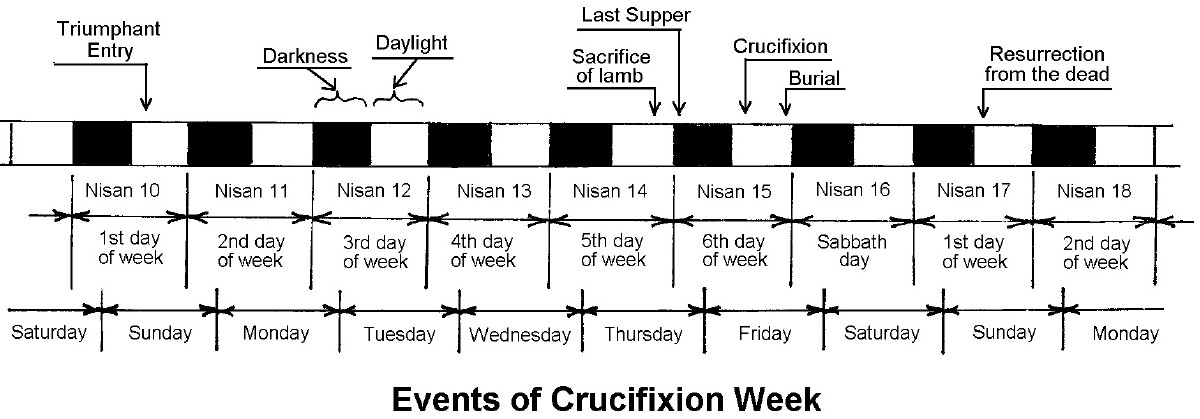<<pg 5-Aphikomen pages: 1|2|3|4|
TIMING OF EVENTS OF CRUCIFIXION WEEK
The chart below is my studied calculation of the sequence of events of that week. It’s drawn to illustrate the differences between Jewish, Roman, and American timing methods, and to correlate and explain Scriptural applications.
1) On the chart below, the shaded areas represent hours of darkness; the open boxes represent daylight hours. Jewish days always begin and end at sunset — the beginning of darkness. Remember the creation days in Genesis 1 — they’re called “the evening and the morning.” To the Jew, evening meant the early hours of darkness. The phrase “between the evenings” meant daylight hours. Our present, non-Jewish, days always begin and end at midnight — the middle of darkness.
2) Exodus12:6 says the Passover lamb should be kept penned up until Nisan 14, then killed “in the evening” (KJV) or “between the evenings” (Hebrew). This would be in the afternoon toward the end of Nisan 14. Josephus said this was done between the 9th and 11th hours of the day, that is, between 3 and 5 PM. This would be on our Thursday afternoon.
3) Exodus 12:7,8 says that, for that first Passover, they were to put the blood on the top and both sides of their doorways, then eat the flesh that night (during the first part of Nisan 15). Therefore the Last Supper must have been on Thursday night.
4) Exodus 12:12,29 says that God killed the first-born of all Egyptians at midnight that night (Nisan 15). Thus the actual Passover Day is Nisan 15 — the day after the lamb was killed.
5) Jesus was arrested a few hours after His Last Supper (a Passover meal), was tried during the night, and was crucified at about 9 AM the next day. This was on Nisan 15 (Passover Day), which would be on our Friday. He was on the cross from 9 AM until 3 PM (see Mark 15:25,34).
6) The day He was crucified was a “day of preparation” for the Sabbath, that is, a Friday (see Mark 15:42). They had to put His body in a tomb quickly, before sundown, else it would be during the Sabbath, when burial was forbidden. This couldn’t have been the day of preparation for the Passover, because Mark 14:12 says that’s when the two disciples set up the upper room for the Passover feast.

7) Early in the morning after the Sabbath was past, on the first day of the week, that is Sunday, the women came to complete the burial anointing (see Mark 16:1). But He was not in the tomb — He had risen from the dead!
8 ) Jews always counted a fraction of a day as one day. Thus He was in the grave for three days from Friday afternoon until Sunday morning. The short portion of Friday, plus all of Saturday, plus part of Sunday added up to three days. These were Nisan 15, 16, and 17.
9) Exodus 12:3 says that the Passover lamb was to be selected on Nisan 10, and was to be kept penned or checked for blemishes until Nisan 14. This gives a good analogy for the date of Jesus’s Triumphant Entry into Jerusalem, which was on the first day of the week, Sunday, Nisan 10.
10) Some people disagree with this timing, pointing out phrases that said Jesus was in the tomb for three days and three nights, or that “after three days” (rather than “on the third day”) He rose again. This writer recognizes an apparent conflict here, but feels the overall evidence favors the timing shown here. Another evidence is the conversation on the road to Emmaaus, in Luke 24:13,21. The KJV says clearly that this took place “on the third day,” but the Jerusalem Bible (more faithful to the Hebrew text) says “two whole days have gone by since it happened.”
11) In what year did this occur? Scholars are not quite agreed here. Rabbis have changed the way that Passover is calculated, partly so that it won’t fall on a Friday, but apparently Passover did come on Friday in both A.D.30 and A.D.33. The Chronology History Research Institute gives a number of constraints that rule out A.D.33. They conclude that Jesus must have been crucified in A.D.30. This also fits in with the forty-year interval before the destruction of the Temple by Titus in A.D.70. But Grant Jeffrey, in Armageddan: Appointment With Destiny figures that Jesus was crucified in A.D.32. Other writers have suggested other dates, so that this writer just won’t claim a particular ancient year.
The Bottom Line
No matter what is the correct calendar date, we should remember that the important thing is not the exact date on which Jesus hung on the cross, was buried, and then rose from the dead. The important thing is that He did, and thereby gave us the chance for everlasting life with God.
Jesus said, “I am the way, the truth, and the life: no man cometh unto the Father, but by me.”
Considering the obvious importance of what we’ve described, the reader should consider this — yes, Jesus was the true Passover Lamb of God, and He did truly die for the sins of the world, but have I followed through on this? Have I personally applied His blood to the “doorpost of my own heart?” Is He truly my Saviour? There’s no other way for salvation, and all it takes is my heartfelt belief in Jesus Christ and what He did for me, together with a simple but sincere prayer of repentence for forgiveness and salvation; He’s eagerly waiting. Are you ready?
<<pg 5-Aphikomen pages: 1|2|3|4|
